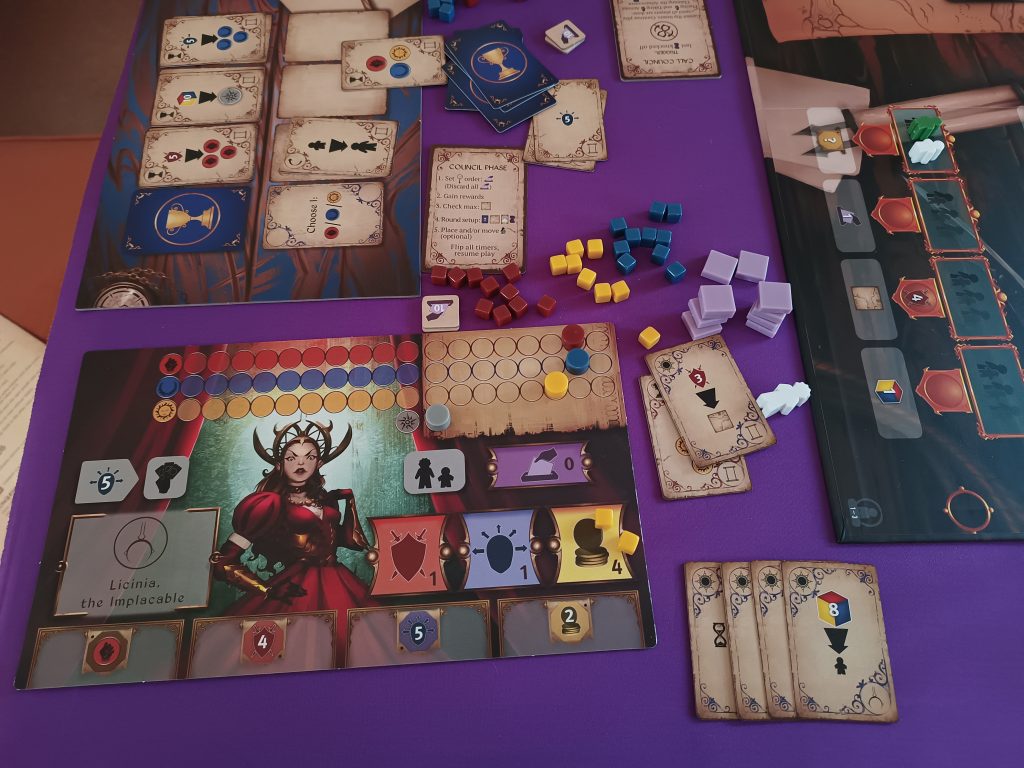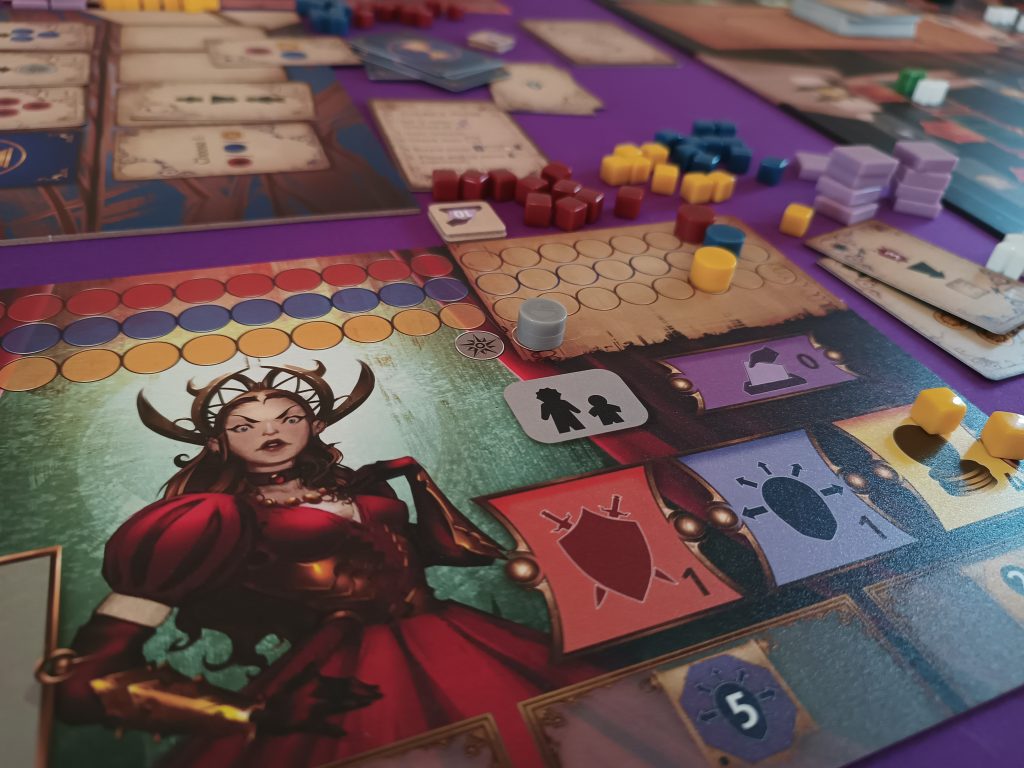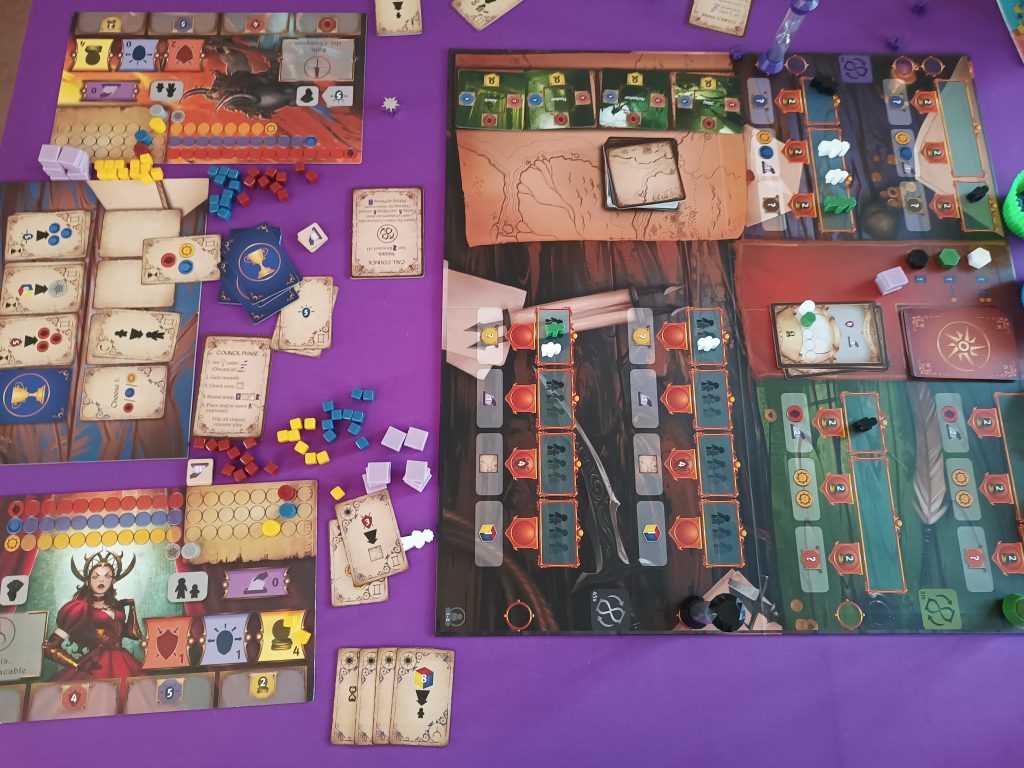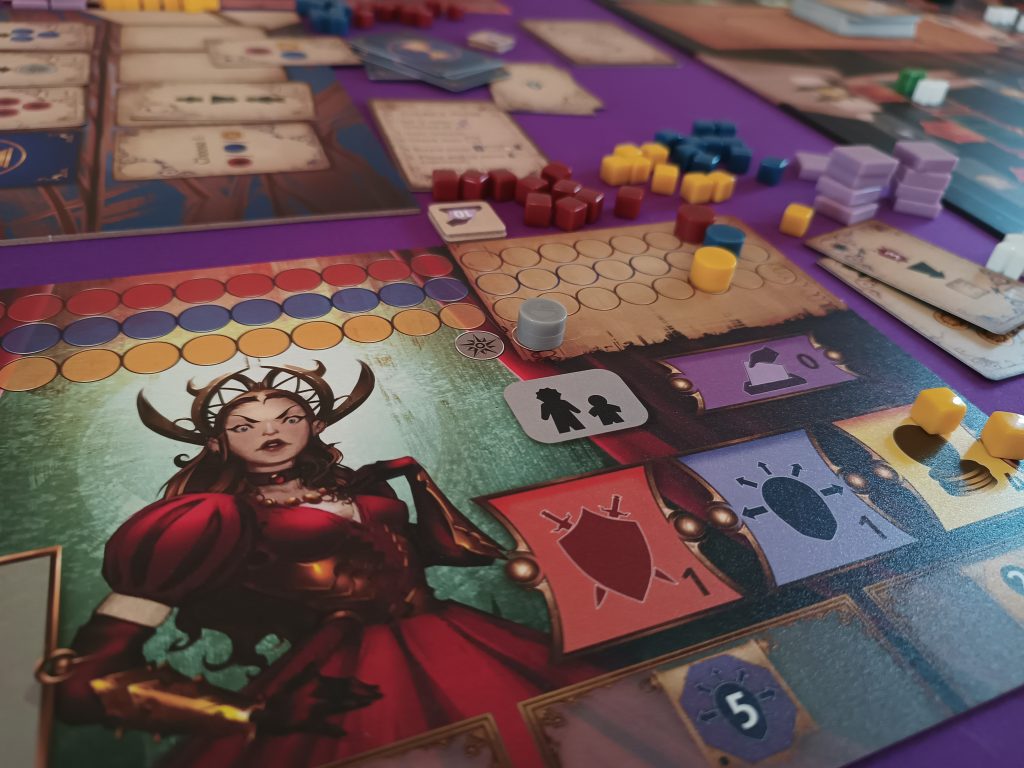BY SAGGYHEAD
Saggyhead is slowly watching the sands of time in Pendulum by Travis P Jones and published by Stonemaier Games
Designer: Travis P Jones
Publisher:Stonemaier Games
Artist: Robert Leask
Player Count: 1-5 players
Age 12+
Play time 45-90 mins
Pendulum is a real time game with no set turns or turn order. You are at the command of the sand timers. Planning your moves carefully will ensure that you maximise how much you are able to do each round. Your aim is to get yourself to and beyond the line on your red, yellow and blue tracks to ensure your chance at victory.
I make no secret that I really like the Stonemaier production. I enjoy all of their games that I’ve played both multiplayer and solo using the Automa Factory. Looking at the theming, it seemed kind of political fantasy which honestly wasn’t much my vibe, but I trusted in the publisher and having put out so many games I have enjoyed. It doesn’t feel like your typical Stonemaier production, the components are different not in quality but in feel in hand. The artwork is as you would expect on the box, but there isn’t much detail to the board or cards. They are more functional than pretty. What you do see though is strong iconography and a clear board where the actions are well spaced out.
Initial Thoughts
I was a little hesitant with Pendulum as it is a real time game which is notoriously not Marv’s favourite kind of game. He is easily spooked and stressed out by the angst of playing games against the clock. However with the recent success of playing Rush MD, he was open to giving this a bash. The similarities between the two games really end at the use of the sand timers to determine when you can perform actions, but that was enough of an in so I ran with it.
The game was nothing like what I was expecting from the descriptions I have heard on the grapevine. I was expecting a frantic real time action selection frenzy with no down time except between rounds where the speediest hands are rewarded. Yet instead it was far more measured and far less about speed, a wrong move would tie up your workers for much longer than intended.

Gameplay
The tagline of the game is “Time is the most precious resource as you attempt to rule Dünya”. Each player plays as a noble who is vying for power as the Timeless King and to take control of the kingdom. The game aim is to get your pieces over the “finish line” by working up all the tracks. You collect victory points through actions you decide to take, and through performance on end-of-round council phases.
The action spaces are split into 3 colours; black, green and purple. Each has two rows of actions and is controlled by the sand timer. You can place your workers into the row without the sand timer, but cannot take the action until the sand timer is flipped to that row. You cannot move a worker whilst the timer is still on that row. So you must place your workers carefully to ensure you get what you need done but that you also are able to keep taking actions throughout the round. The black timer is only for 45 seconds so these workers are released from their duty pretty quickly. The green actions are more powerful but your workers are tied up for two minutes whilst doing them. The most powerful actions are controlled by the purple sand timer, but these claim your workers for a full 3 minutes.
The start is asymmetric and every character starts at different points on each track. This is combined with player specific card decks that provide you with extra actions to help you on your way. These are essential to the balance of the game I think. In a two player game, I do think that some tracks are easier to move up than others purely because of the way in which spaces are blocked off by the neutral player pieces. I guess you just need to be a bit smarter about the way you work your turns.
Gameplay is all about gaining votes to ensure turn order and rewards in the council phase, and yellow red and blue resource cubes in order to perform actions, build your engine and move up victory point tracks. Boiled down to the basics, Pendulum does not sound particularly unique, however the nuances of the mechanisms really create a game like no other I have played.

Components
My initial thoughts upon opening the box was one of surprise, the typical wooden components were nowhere to be seen, the game components were mostly plastic. This wasn’t necessarily a bad thing, just I guess a surprise. The pieces are sizewise easy to use, and visually it is really easy to tell the colours and pieces apart at a quick glance which is super important in a game where you are all moving independently of one another.
One component I really don’t like is the player boards that are made of a texturised plastic. It is durable, easy to read and very much suitable for the job. I just really dislike the feel of it. It makes a noise akin to knives scratching on plates to me that just sets my teeth on edge. Maybe that is just me, but I think setup is not nearly as fun when putting out the player boards makes me feel all funny inside.
Why Do I Love This Game?
If you are thinking that this will be a real-time stress inducing game then you’d be wrong. It isn’t as it initially seems. Pendulum is far calmer than it has any business being. It is fraught with difficult decisions and the theme of managing time is prevalent through the gameplay and mechanisms. There always feels like there is more that you want to do each round.

What is not to love?
If you want something smooth and strategy heavy then this simply isn’t going to tickle your itch. The game itself is not particularly deep in its strategy, but I think it is thoroughly enjoyable for exactly what it claims to be. A turnless game where you are trying to maximise your use of your actions whilst still being beholden to the sand timer. I also found some of the rules a little fiddly, they didn’t always feel intuitive. This is something that I find often with more unique games. I don’t have a good frame of reference for how the game will pan out so it becomes a bit more tricky for me.
I prefer wooden components over plastic, but these are nicely produced components. I think aside from the player boards which have textured plastic that I really don’t like at all. The rest of the components are really nice. The cards are generally simple in artwork except the land cards which are really beautiful and all unique.
Round Up
I do believe that from first impressions this game is a 6/10, but as the nuances of the mechanisms shone through on subsequent plays the score kept climbing. I don’t believe that this will ever be my favourite real time game, but I think it definitely has its place in the collection. If you like the theming then this might hit higher for you from the off. For me the fantasy theme isn’t the most engaging, but I do think the theme of being a time master is ever present. This game does what it says in a new and intriguing way and for that reason I think you should give it a go.
SaggyScore: 70/100
Likes
- The gameplay is far more relaxed than I expected for real-time
- Icons are clear and the spacing is good, you don’t feel like you are playing on top of one another.
- It is simply 4 rounds, and does not overstay its welcome at all.
Dislikes
- It’s not actually real-time as you know it which kind of confused me
- Not overly intuitive gameplay. The icons are really clear and so the actions are too, but some of the rules took us a few rulebook dives to get. Which in a real-time game is a bit messy.
- The player boards are kind of scratch plastic and really not nice to touch



